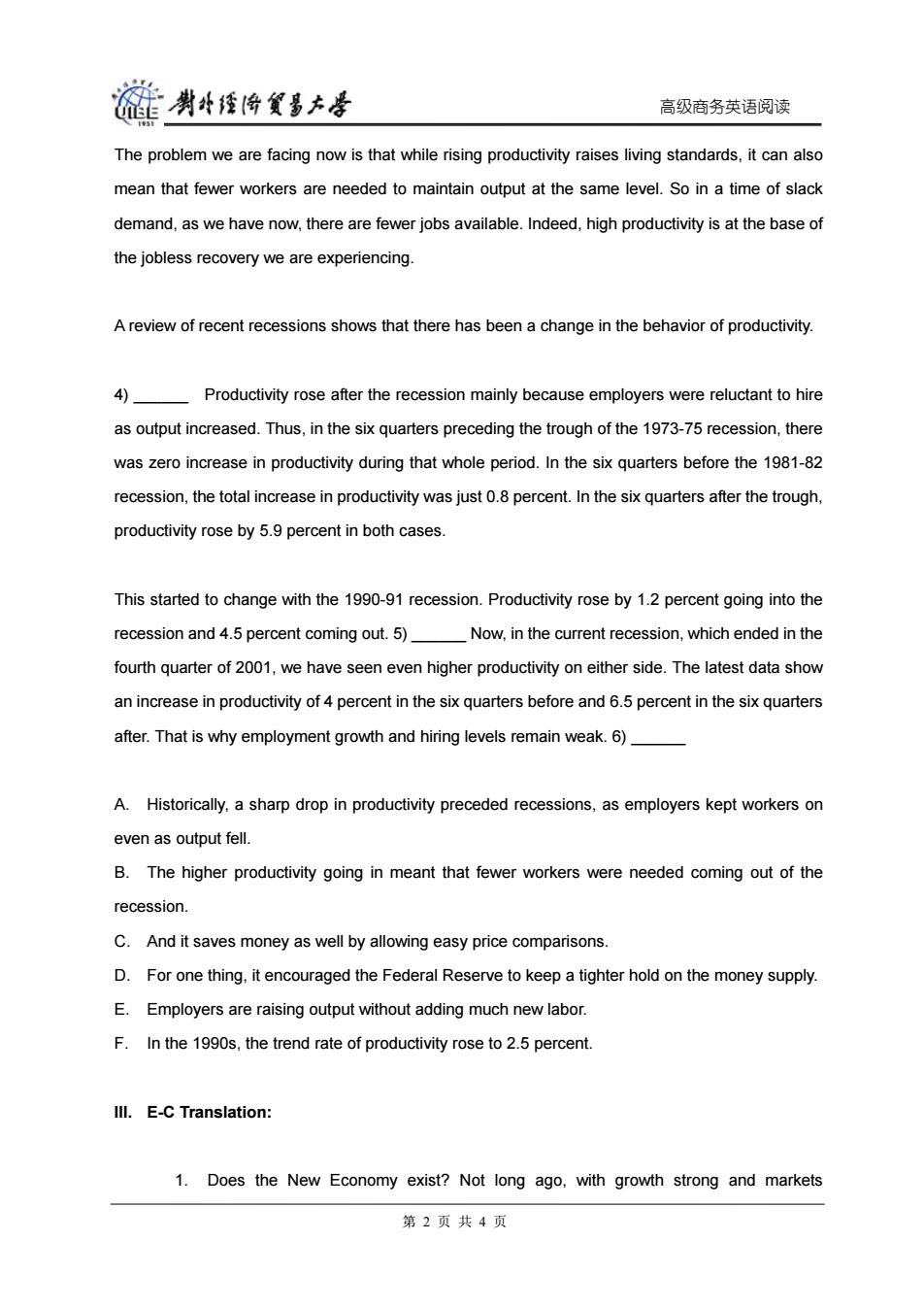正在加载图片...

碰剥经悔贸昌大号 高级商务英语阅读 The problem we are facing now is that while rising productivity raises living standards,it can also mean that fewer workers are needed to maintain output at the same level.So in a time of slack demand,as we have now,there are fewer jobs available.Indeed,high productivity is at the base of the jobless recovery we are experiencing. A review of recent recessions shows that there has been a change in the behavior of productivity 4) Productivity rose after the recession mainly because employers were reluctant to hire as output increased.Thus,in the six quarters preceding the trough of the 1973-75 recession,there was zero increase in productivity during that whole period.In the six quarters before the 1981-82 recession,the total increase in productivity was just 0.8 percent.In the six quarters after the trough, productivity rose by 5.9 percent in both cases This started to change with the 1990-91 recession.Productivity rose by 1.2 percent going into the recession and 4.5 percent coming out.5)_Now,in the current recession,which ended in the fourth quarter of 2001,we have seen even higher productivity on either side.The latest data show an increase in productivity of 4 percent in the six quarters before and 6.5 percent in the six quarters after.That is why employment growth and hiring levels remain weak.6) A.Historically,a sharp drop in productivity preceded recessions,as employers kept workers on even as output fell. B.The higher productivity going in meant that fewer workers were needed coming out of the recession. C.And it saves money as well by allowing easy price comparisons. D.For one thing,it encouraged the Federal Reserve to keep a tighter hold on the money supply. E.Employers are raising output without adding much new labor. F.In the 1990s,the trend rate of productivity rose to 2.5 percent. Ill.E-C Translation: 1.Does the New Economy exist?Not long ago,with growth strong and markets 第2页共4页高级商务英语阅读 The problem we are facing now is that while rising productivity raises living standards, it can also mean that fewer workers are needed to maintain output at the same level. So in a time of slack demand, as we have now, there are fewer jobs available. Indeed, high productivity is at the base of the jobless recovery we are experiencing. A review of recent recessions shows that there has been a change in the behavior of productivity. 4) ______ Productivity rose after the recession mainly because employers were reluctant to hire as output increased. Thus, in the six quarters preceding the trough of the 1973-75 recession, there was zero increase in productivity during that whole period. In the six quarters before the 1981-82 recession, the total increase in productivity was just 0.8 percent. In the six quarters after the trough, productivity rose by 5.9 percent in both cases. This started to change with the 1990-91 recession. Productivity rose by 1.2 percent going into the recession and 4.5 percent coming out. 5) ______ Now, in the current recession, which ended in the fourth quarter of 2001, we have seen even higher productivity on either side. The latest data show an increase in productivity of 4 percent in the six quarters before and 6.5 percent in the six quarters after. That is why employment growth and hiring levels remain weak. 6) ______ A. Historically, a sharp drop in productivity preceded recessions, as employers kept workers on even as output fell. B. The higher productivity going in meant that fewer workers were needed coming out of the recession. C. And it saves money as well by allowing easy price comparisons. D. For one thing, it encouraged the Federal Reserve to keep a tighter hold on the money supply. E. Employers are raising output without adding much new labor. F. In the 1990s, the trend rate of productivity rose to 2.5 percent. III. E-C Translation: 1. Does the New Economy exist? Not long ago, with growth strong and markets 第 2 页 共 4 页